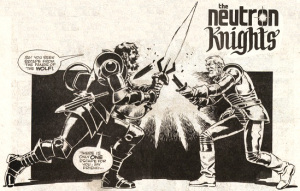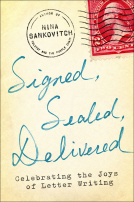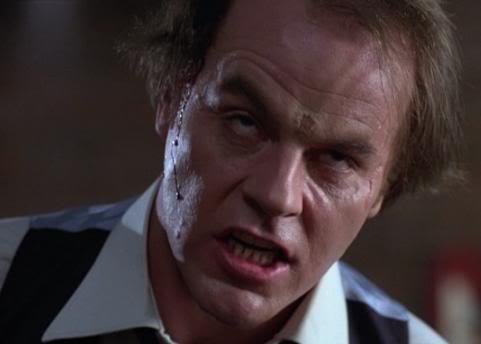First published in Doctor Who: A Marvel Monthly in January 1982. On TV, the Fifth Doctor, Tegan, Nyssa and Adric begin their twice-weekly adventures with “Castrovalva” and “Four to Doomsday”.
You can make the argument that the enjoyment of any piece of art, entertainment or popular culture is influenced by whatever mood you’re in at the time. But at least in terms of the stories I’ve covered on this blog so far, that’s never been truer than with this story. I’ve honestly had difficulty getting my reaction to “The Neutron Knights” down in words, so I’m going to tackle this post in a bit of a different way. First, I’m going to reflect on it through the lens of being in a good, generous mood – and then, I’m going to get my thoughts out assuming a bad, unforgiving mood.
 Good Mood
Good Mood
It’s certainly a creative idea, and shows that Steve Parkhouse is already starting to shape the stories and themes of the comic to suit himself. It’s been a long time since I read the Fifth Doctor comic adventures, but I know that this entire story is a prologue to those adventures in particular. Having a Doctor’s final strip being set-up for what’s to come, rather than a celebration of or farewell to that version of the Time Lord, is pretty bold. What to do with a Doctor’s final story is something that will be tackled in lots of different ways over the course of the strip, given that they just have to stop using a particular Doctor one week and start with another the next.
So Parkhouse gives us a one-shot that is all set-up, and brings in some pretty intriguing ideas that are well-visualised by Dave Gibbons. Every panel in this story seems to ask another question, as well as sparking the imagination at every turn. Techno-versions of the Arthurian legends fighting lightsaber-wielding Knights at the End of the World? There’s no version of reality where that isn’t completely awesome.
How do Merlin and Arthur exist in the future? Who is Catavolcus? Why did the Doctor need to be here at this moment in time? These are questions that aren’t going to be answered for a little while, but do they need to be answered here? Head down a few paragraphs for my “Bad Mood” version of this answer, but Doctor Who has always been about the unanswered questions. From the title of the show itself, to the secrets of the TARDIS and the Doctor’s own history, the show dismisses the idea that those questions should be answered, or even that those questions are very interesting at all.
This one-shot ends the Fourth Doctor era not on a note of sadness, or regret, or melancholy – but with a stark message that the journey continues, and that the Doctor’s adventures are only just beginning. What better way could there be to wrap up this era of the comic strip, and welcome a brand new Doctor?
Bad Mood.
Any way. Literally any other way would have been better.
There’s a level of self-indulgence here that doesn’t bode well for the next phase of the strip. After a run of stories where it almost seems like he’s been trying to get himself other jobs, Steve Parkhouse seems to be saying with “The Neutron Knights” that he’s just going to shape the strip – and the Doctor – to tell the stories he wants to tell. That’s not a bad thing by itself – the strip should reflect the creative team in charge at the time. The issue here is that Parkhouse only provides maddening and frustrating hints as to what he wants to do with Doctor Who.
It’s one thing to write a prologue story. With my limited knowledge of comics, I think this is actually fairly common. The problem here is that this is the Fourth Doctor’s last story, and he spends the entire time with absolutely no idea what is going on, with no agency to affect or even understand events, and is left to wonder whether the whole thing even happened or not. Readers are in the exact same position, and it’s hard not to get the last panel and go “well what was the point of that”?
Setting up mystery and questions that will eventually be answered is an OK goal, but to me Parkhouse falls on the wrong side of too much enigma and forgets to actually tell a story. As a reader, I have no idea why any of what we just saw happened – or even if it actually did happen. The best account of this story that can be made is that the Doctor arrives in the middle of a future battle and evacuates some people in his TARDIS. Not exactly thrilling stuff. This would have been average as just another story in the run, but as the Fourth Doctor’s last hurrah? It’s a very poor decision.
Turning down my bad mood a bit, I know that some of this is informed by being a child of the Wilderness Years and fan of the New Series. Final stories are big and important and dramatic, to an extent they weren’t back in the Classic run. So I’m maybe asking for something unreasonable of a comic strip in 1982.
But… the TV series had just farewelled Doctor #4 with “Logopolis”, a strange mixture of epic destruction and maudlin reflection. It clearly was a big deal for the show, and the Fifth Doctor will bow out in a story that also pulls out all the stops. It’s a shame that in the comic pages, the Fourth Doctor wasn’t given that opportunity.
But, whether I’m in a good mood or a bad mood, the result is the same. We say farewell to the Fourth Doctor and welcome the Fifth, and begin to really see Steve Parkhouse’s vision for the series.
Incidentally, a Merry Christmas to all of you at home!
Scheduling note: I’ll be taking a few weeks off from weekly posts to catch my breath, but will be back soon with the Fifth Doctor’s comic debut in “The Tides of Time”.
Advertisements Share this:




